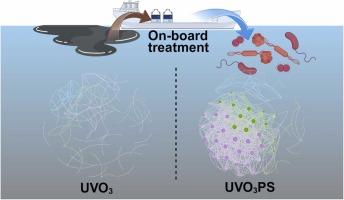Enhanced photo-ozonation for on-board marine oily wastewater treatment: An integrated study on efficiency and microbial trajectory
IF 11.3
1区 环境科学与生态学
Q1 ENGINEERING, ENVIRONMENTAL
引用次数: 0
Abstract
On-board treatment of marine oily wastewater can avoid the costly transportation of large waste streams to shorelines. Employing on-board photo-ozonation, particularly ultraviolet (UV) plus ozone (O3) (UVO3) and persulfate (PS) enhanced UVO3 (UVO3PS), can realize promisingly rapid degradation of various oil components. However, direct discharge of treated effluents to marine environments would still bring unpredictable impacts on ecosystems. Herein, we integrate a photo-ozonation system with marine microcosms to clearly elucidate the treatment efficiency and microbial trajectory responding to the treated light and heavy oily wastewater over time. Results show that both processes can mineralize above 90% of crude oil within 60 minutes by substantially removing n-alkanes and aromatics, and the incorporation of PS generates more powerful radicals to enhance the breakdown of products with nearly 36% lower operating cost. The microcosm results evidence that diverse hydrocarbon-degrading bacteria are enriched over time. Besides, the long-term incubation of UVO3PS-treated oily wastewater enriches members capable of degrading labile organics, intensifies the co-occurrence of genera participating in nitrogen and sulfur metabolisms, and stimulates the microbial trajectory for natural attenuation. Due to the environmental and economic benefits provided by UVO3PS, it is believed that this process can be selected as a promising option for on-board marine oily wastewater treatment.

强化光臭氧处理船上含油废水:效率和微生物轨迹的综合研究
船上处理海洋含油废水可以避免将大量废物流运输到海岸线的昂贵费用。利用机载光臭氧氧化,特别是紫外线(UV) +臭氧(O3) (UVO3)和过硫酸盐(PS)增强的UVO3 (UVO3PS),可以实现各种油组分的快速降解。然而,将处理后的污水直接排放到海洋环境中,仍会对生态系统造成不可预测的影响。在此,我们将光臭氧化系统与海洋微生物相结合,以清楚地阐明处理后的轻油和重油废水的处理效率和微生物轨迹随时间的变化。结果表明,两种工艺均可在60分钟内通过大量去除正构烷烃和芳烃实现90%以上的原油矿化,且PS的加入产生了更强的自由基,提高了产品的分解效率,运行成本降低了近36%。微观结果表明,随着时间的推移,各种碳氢化合物降解细菌丰富了。此外,uvo3ps处理过的含油废水长期孵养,丰富了能够降解活性有机物的成员,加强了参与氮硫代谢的属的共生,刺激了微生物轨迹的自然衰减。由于UVO3PS提供的环境和经济效益,相信该工艺可以作为船上含油废水处理的有前途的选择。
本文章由计算机程序翻译,如有差异,请以英文原文为准。
求助全文
约1分钟内获得全文
求助全文
来源期刊

Journal of Hazardous Materials
工程技术-工程:环境
CiteScore
25.40
自引率
5.90%
发文量
3059
审稿时长
58 days
期刊介绍:
The Journal of Hazardous Materials serves as a global platform for promoting cutting-edge research in the field of Environmental Science and Engineering. Our publication features a wide range of articles, including full-length research papers, review articles, and perspectives, with the aim of enhancing our understanding of the dangers and risks associated with various materials concerning public health and the environment. It is important to note that the term "environmental contaminants" refers specifically to substances that pose hazardous effects through contamination, while excluding those that do not have such impacts on the environment or human health. Moreover, we emphasize the distinction between wastes and hazardous materials in order to provide further clarity on the scope of the journal. We have a keen interest in exploring specific compounds and microbial agents that have adverse effects on the environment.
 求助内容:
求助内容: 应助结果提醒方式:
应助结果提醒方式:


